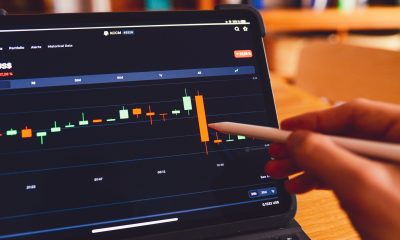Crypto
Bitcoin Rally after Halving Fails to Materialize. Bitcoin ETFs Also in the red
Bitcoin’s price has dropped below $60,000 since August, after peaking at $70,000 in July. Investors are liquidating Bitcoin ETFs, losing about $100 million daily. Despite past Bitcoin Halving events boosting prices, this year’s halving hasn’t delivered similar gains. Analysts suggest ETFs now have more influence on BTC prices than halving, with critical support levels at $56,000 and $49,000.

The price curve of Bitcoin (BTC) has lost positive momentum. Experts explain this with two reasons: the usual influence of the halving has become obsolete and the new ETFs are losing capital.
The good mood on the crypto markets has evaporated, the leading currency Bitcoin (BTC) has closed many trading days in the red and has been trading below the psychologically important mark of $60,000 since the end of August. At the end of July, Bitcoin was still worth $70,000.
When assessing the situation, two influences are currently noticeable from the perspective of the crypto scene:
According to data from SoSo, the Bitcoin ETFs, which have only been traded since January, last saw an inflow of capital on August 26th, and investors have been liquidating positions since then. On average, Bitcoin ETFs are currently losing around $100 million in capital on stock exchange working days.
Measured against Bitcoin’s market capitalization of $1.1 billion, these are not huge amounts, but the psychological factor should not be underestimated. Anyone who thought that Bitcoin ETFs would ensure a steady inflow of capital as they did in their early months will now be proven wrong.
Many investors had expected that the Bitcoin Halving, which only takes place every four years, would have positive effects on the price development of BTC as in the past. But that has not happened since the most recent Halving took place in the second half of April. Analysts at Outlier Ventures published a report this week with the headline “Bitcoin Halving. The four-year cycle is dead.”
The report compares the four previous Bitcoin halvings. As is the case now, 125 days after the halving, Bitcoin had gained a good 700 percent in 2012, in 2016 it was plus 10 percent and in 2020 around 22 percent. But in 2024, four months after the halving, the price curve of BTC is minus 8 percent in the charts. Even before this year’s halving, there was a lively debate about whether the event was losing relevance .
Outlier Ventures believes that 2020 is already a special case because at that time money was distributed generously in the USA and other countries to cushion the economic consequences of the Corona crisis. They differentiate: The Bitcoin halving was previously able to influence the BTC price curve from the supply side, but this weakened. The Bitcoin ETFs, on the other hand, were able to increase demand, but this trend is currently running out.
Conclusion: Bitcoin hopes for momentum
Following the Bitcoin halving, BTC had in the past reached a new all-time high each time, albeit with a time delay. In 2024, a different dynamic set in. Driven by the initial success of the BTC ETFs, Bitcoin rose to a new record price of just under $74,000 in mid-March, a month before the halving.
Some observers believe that this shows how the ETFs have overtaken the halving in terms of importance. They now cite price levels of $56,000 and $49,000 as critical support levels for Bitcoin. But of course there are also optimists who predict a renewed Bitcoin upswing from October after the summer holidays and hope for support from the US presidential race. The fact is: At current prices of around $57,000, Bitcoin seems to be trading at a level that reacts nervously to external influences.
__
(Featured image by TamimTaban via Pixabay)
DISCLAIMER: This article was written by a third party contributor and does not reflect the opinion of Born2Invest, its management, staff or its associates. Please review our disclaimer for more information.
This article may include forward-looking statements. These forward-looking statements generally are identified by the words “believe,” “project,” “estimate,” “become,” “plan,” “will,” and similar expressions. These forward-looking statements involve known and unknown risks as well as uncertainties, including those discussed in the following cautionary statements and elsewhere in this article and on this site. Although the Company may believe that its expectations are based on reasonable assumptions, the actual results that the Company may achieve may differ materially from any forward-looking statements, which reflect the opinions of the management of the Company only as of the date hereof. Additionally, please make sure to read these important disclosures.
First published in BLOCK-BUILDERS.DE. A third-party contributor translated and adapted the article from the original. In case of discrepancy, the original will prevail.
Although we made reasonable efforts to provide accurate translations, some parts may be incorrect. Born2Invest assumes no responsibility for errors, omissions or ambiguities in the translations provided on this website. Any person or entity relying on translated content does so at their own risk. Born2Invest is not responsible for losses caused by such reliance on the accuracy or reliability of translated information. If you wish to report an error or inaccuracy in the translation, we encourage you to contact us

-

 Crypto1 day ago
Crypto1 day agoGoldman Sachs Upgrades Coinbase, Citing Strong Growth Outlook
-

 Cannabis1 week ago
Cannabis1 week agoMedical Cannabis vs Street Weed: Why Therapy Makes More Sense in 2025
-

 Markets3 days ago
Markets3 days agoGold, Liquidity, and Market Complacency Heading Into 2026
-

 Cannabis1 day ago
Cannabis1 day agoAgential Cannabis 2026 Set to Spotlight Southeast Asia






















